September 15th, 2009 · No Comments
-
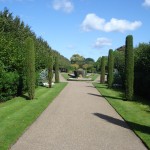
-
Regents Park
-
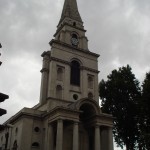
-
Christ’s Church
-
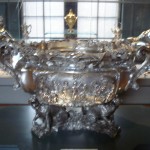
-
The Silver Exhibit in the V&A
-
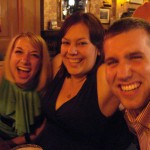
-
Having a Good Time at the Fitzroy
Like many of my classmates I decided it would be worthwhile to summarize all of my discoveries this month in London. During this post I will focus on six main themes found within London: Parks, Churches, Pubs, Other Religious Institutions, Theatre and Museums.
Parks
Each park that I visited had its own distinct characteristics that separated it from any other. Green Park was the first I visited and after perusing a few others, I realized there was nothing that exciting about it. Located right across from Buckingham Palace, Green Park certainly provides a good place to go and take a break from the busy atmosphere of the area. Besides this however there is not much going on and I would recommend that potential park goers walk the extra distance over to St. James Park.
In addition to the large number of waterfowl heckling people for food which offers consistent entertainment St. James offers some picturesque flower beds throughout and various monuments along the way. It has the relaxing atmosphere of Green Park with a bit more excitement sprinkled in.
Regents Park offers a completely different feel from Green or St. James. Located in a separate area of London, Regents Park has a history of being used by a higher end crowd. I could tell this immediately from the feel of the park. The decorative shrubbery and elegant architecture throughout gave me a feeling that Regents is not as well used as other parks.
Since I was one of the members of the Parks group that gave a walking tour of Hyde Park and Kensington Gardens I could go into a lot more detail about these two green spaces but I will choose not to in an effort to be concise. In summary Hyde Park is the largest green space in London and is often used for larger events such as concerts, festivals etc. It also contains a large number of monuments throughout including the 7/7 memorial and the Diana Memorial Fountain. Kensington Gardens is home to a variety of key monuments but is not as well trodden as Hyde. Overall it makes for a quieter atmosphere, more conducive fo reading or “snogging”.
Regents Park were my two favorite green spaces in London. Regents, is both beautiful, and extremely large and I continually felt the need to go back and explore. Kensington Gardens appealed to me in that it was quainter than Hyde Park but contained a like amount of history and monuments throughout. Although I would be content spending a length of time in any London green space Regents and Kensington would be my top choices.
Theatre
Overall I enjoyed going to the theatre on so many occasions. What better place to do so than in London after all? Here I will discuss my favorite performances and theatre venues.
All in all I enjoyed all but two of the performances we saw. The two Shakespeare productions at The Globe Theatre were fantastic. Although I did not particularly enjoy reading Troilus and Cressida it made a huge difference to be there so close to the actors. The fantastic drum chorus at the end really sealed the deal. As You Like It was probably my favorite show I saw here in London. Although it is one of Shakespeare’s simpler plays the actors really made it jump off the page. Being down it the pit was fantastic because of all the ad-libbing and constant interaction with the crowd. I even felt traces of Touchstone’s saliva on my arm at one point.
The other Shakespeare performance I saw, All’s Well That Ends Well, was lackluster. Although the Olivier was my favorite performing venue (this is what an auditorium style theatre should be like…why can’t Dickinson have something like this?) the play itself was odd and ended on an abrupt and odd note.
The other play we saw at the National Theatre, The Pitmen Painters, was fantastic. Although I was dozing a bit because of the Benadryl I took right before the show, the actors kept my attention and I appreciated that the play was based off of a true story.
Easily the oddest play we saw was Arcadia. An extremely intelligent performance the play juxtaposed two different periods in time and created a singular storyline in which the plot was based. Overall it was an entertaining performance that made me think early and often.
Finally there was Blood Brothers. The lone musical I saw produced feelings of disbelief, anguish and held back laughter. The ridiculous 80’s sound track and creepy narrator just didn’t do it for me. I think it’s safe to say that I was not the only one from Humanities 309 who was a bit surprised to see just about everyone in the audience give it a standing ovation.
I had a very positive experience with the theatre here. I would go back to the globe again and again. I loved being that close to the action. I would also enjoy seeing another show in the Olivier. There really is so much to choose from here. It’s simply a matter of figuring out your tastes and saving your money so you can see a lot of performances.
Churches
From Westminster Abbey to St. Paul’s Cathedral we saw most of the major churches/cathedrals during our month in London. St. Paul’s was easily my favorite. From the fantastic crypt to the hundreds of stairs up to the tower it had so much to offer in the way of history and mystique. Westminster Abbey fascinated me primarily because of all the literary figures that had been buried inside as well as the room that was dedicated to “The Order of the Bath”. Other churches that I really enjoyed taking a look at were: “St. Martin in the Fields” which sits just outside Trafalgar Square and Nicholas Hawkesmoore’s “Christ’s Church” which is located in very close proximity to Brick Lane.
Other Religious Institutions
Overall the Sikh Gurdwara was my favorite place that we visited. I appreciated the simplicity of the religious doctrine as well as the conviction and honesty with which our tour guide, Mr. Singh spoke. The morning was capped off with a fantastic sit down meal together in which everyone was served the same food and drink.
I had different feelings about the Hindu Mandir. It was clear to me from the very beginning that the Hindu religion is not nearly as modest as Sikhism nor are they trying to be. From the extremely decorative prayer room, to the museum located right in the center of the Mandir I never felt particularly comfortable inside.
The only religious institution I wish we had gotten a chance to visit is a Mosque. I had been to one many years ago but I did not remember a whole lot from my experience. I wonder how much more lively the East End, and all parts of London would be if Ramadan were not taking place during our time here.
Museums
I could go on and on about museums so I will attempt to stay as concise as possible.
The British Museum was massive, convenient since it was so close to the Arran House but a little one dimensional at times. One of my favorite exhibits at the British Museum was a special exhibit on Living and Dying that drew information from all different time periods and cultures.
The National Gallery was fantastic. Although I have a hard time appreciating some visual art the gallery kept my attention for a number of hours. Seeing so many famous works of art was phenomenal.
The Tate Modern was my least favorite museum here. Although I am trying I have a hard time understanding modern art. After about 45 minutes in this museum it ended up being too much for me.
The Cabinet War Rooms/Churchill Museum were two of my favorites. The realization that I was standing in one of the most important places in World War II history was unbelievable. The War Rooms felt so authentic. I really felt as though I had been taken back in time to the 1940’s while inside.
The Victoria and Albert was easily my favorite museum in London. There was so much variety inside and so much to see. I could have easily spent a few days inside. Two of my favorite exhibits were the silver and jewelry exhibits. I’m not sure what this says about me as a person but I found it unbelievable that individuals could even own such treasures. I also enjoyed the laid back atmosphere of the V&A staff. At most of the other museums I visited I felt like I was doing them a disservice simply by being there. Although I understand that taking pictures of an object in a museum doesn’t do it justice I like to be able to have the option of doing so.
The Sir John Soane museum interested me but it wasn’t really my cup of tea in the end. It also had a stuffy atmosphere to it that I didn’t really appreciate.
One thing I can draw from my experience at museums here is that each and every one has something that distinguishes it. With so many museums I thought that it would be impossible to avoid some overlap but I never really felt that. Cheers to London and its museums.
Pubs
Finally we have pubs. What would London be without it’s public houses? In some cases pubs are the true museums of London, designating what an area was like in the past and what type of clientele it attracted. During my month here I had a chance to visit a few pubs and get a general sense of what some possible differences could be. It is clear to me that each pub brings something different and unique to the table. The Marlborough Arms was convenient being so close to the Arran House and was a great place to enjoy a pint over a meal with friends. The Court was conducive to socializing in a different way. The music was louder, the people louder and the drinks cheaper. Other places I visited offered other things that made them stand out as well. One thing that i’ve learned about pubs is that it’s hard for one to please everyone. Since everyone has different tastes and desires when it comes to pubs you are better off going to one with a small cohesive group.
To conclude this novel I would just like to say that I think we saw a lot of different faces of London this month. I realize there is much more to see here but between walking tours throughout the city, trips to major monuments and museums and individual exploration I have learned a ton about London, it’s history and where it is going. I look forward to more London explorations in the future but for now, ON TO NORWICH!
Tags: Churches and Cathedrals · Henry · Pubs · Theatre
September 14th, 2009 · No Comments
Although I have blogged, to some extent, about most academic things I have done in London, I feel that I have a better impression of most things now than I did at the beginning of the stay. Along this vein, I feel the need to revise, or just plain state, my opinions on the “Big Five” topics – parks, churches, museums, theatres, and pubs.
I have now been to five of the Royal Parks in London. Green Park, Kensington Gardens, Hyde Park, Regent’s Park, and St James’ Park are all very similar and yet very different in their own ways. I found Green Park, situated very close to Buckingham Palace, to have the most unfriendly atmosphere of the five. There is very little to Green Park. There are trees, benches, grass, the ever-popular lawn chairs for rent, and beautiful ornate gates facing Buckingham Palace. I think the reason I found the park so cold is that it was, well, too green. There were no flowers or water features (except for one fountain commemorating the Canadians), just trees, grass, and benches.
This is vastly different from the other four parks I visited. St James’ Park, Hyde Park, Regent’s Park, and Kensington Gardens all were beautifully landscaped with brightly colored flowers, clean fountains, scultpures, and natural or constructed water features. In Hyde Park, Regent’s Park, and Kensington Gardens it was easy to forget that you were in the middle of a pollution-filled city. As I am not much of a city person, it was extremely refreshing for me to not be able to hear or see traffic for a while. With Green Park and St James’ Park, I couldn’t shake that feeling. However, I am a firm believer that parks, whether or not they are within city limits, always make people feel healthier. For this reason and the sheer beauty that the parks portrayed in their different ways, I understand why I did not only see tourists, but the people of London as well.
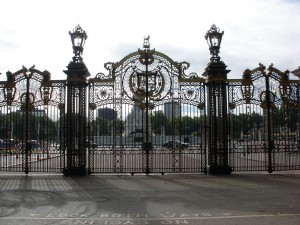
Gates towards Buckingham Palace from Green Park
Churches and other places of worship are an integral part of societies throughout the world. Throughout our time in London, we have been fortunate enough to visit Westminster Abbey, St Paul’s Cathedral, a Sikh gurdwara, and a Hindu temple. Of these four I enjoyed St Paul’s Cathedral the most from a purely historical standpoint and the Hindu temple most from a cultural perspective. St. Paul’s is one of the most recognizable and interesting buildings in London. It not only houses some of the most important military remains in the country (the Duke of Wellington and Admiral Nelson), but it was one of the most iconic images of WWII Britain. I also found it to be less like a museum where I felt like hop-scotching around graves in the floor (Westminster Abbey) and much more like a place of worship.
I enjoyed the Hindu temple for very different reasons. Although there was a definite sense of it being a tourist attraction, with the gift shop in the lobby and the interpretive centre with tiny models of Hindu gods, the temple was still very obviously, well, a temple. Before going there, I had no idea what Hinduism was like. I knew that there are multiple gods and that one is an elephant, but I didn’t know about their dedication to peace and volunteer work. What really struck me about it was that the intricate carving and craftsmanship of the facility was all done by volunteers. I think that this cultural experience was only heightened by being able to observe a service in the sanctuary that was so unlike my own Roman Catholic faith.
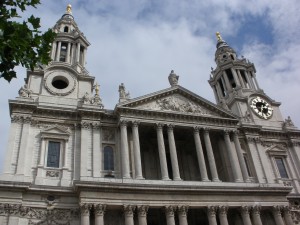
St Paul's Cathedral - a symbol and a place of worship
I had very mixed experiences with museums in London. Some, like the Victoria and Albert, I just didn’t seem to understand in the amount of time I spent there. However, I think that if I went back and dedicated a day to the facility, I would appreciate how the seemingly-random exhibits link together much better. (I did enjoy the items on display in the V&A, I just had an issue with the layout of the museum.) Other museums, like the Museum of London and the Docklands Museum, were put together in a very fluid and informative manner that I enjoyed greatly. My two biggest museum issues were with the British Museum and Sir John Soane’s Home/Museum. Grace and I wrote extensively on our thoughts on the British Museum, so instead of repeating everything, I’ll just give a brief summary: why are all of these amazing artifacts that have no connection to Britain in the British Museum?
The Sir John Soane Museum is a completely different story. I appreciated that the museum was free and displayed an extremely eclectic collection, but please never make me go back there ever again! It was the single most claustrophobic place I have ever been in my entire life with possibly one exception. Call it a personal thing, I do not like it when random pieces of monuments are mounted on the ceiling directly above my head. I am also not a big fan of walking into a room in a house and having literally hundreds of sculpture eyes staring at me from every surface around me. I disliked it so much that I could not even finish going through it, and anyone who has been in a museum with me will know that I read and see as much as I possibly can. I don’t understand why that creepy building perfectly-suited to be a haunted house at Halloween is called a museum. (Please if you can attempt to explain it to me, go right ahead!)
Theatre is a subject I have talked about in a couple of different posts (Observations on Accessibility and Blood Painters and Pitmen Brothers), however, I have not discussed theatre in general. I was lucky enough to see Troilus and Cressida, All’s Well That Ends Well, Arcadia, The Pitmen Painters, and Blood Brothers. Each of these theatre experiences were extremely different, but all valuable in their own ways. Troilus and Cressidawas shown in the Globe Theatre and we had groundling tickets that forced us to stand for the 3 hour performance. The actual standing wasn’t nearly as bad as I thought it would be, but the best thing about the show was being quite literally three-to-four feet away from the actors on stage. (Actually, it was slightly amusing when Hector died and was lying 3 feet away in our line of sight for the last 20 minutes of the play!) The staging of this Shakespearian play was vastly different to All’s Well That Ends Well, which was put on in the National Theatre. In the Globe, the sets are quite minimal because they have to perform four or five different shows on the same stage in the space of a few days. The set for All’s Well That Ends Well was much more elaborate and specialized for the show. Rather than the reliance on the actors and the costumes that the Globe used to tell you where the play was occurring, All’s Well That Ends Well used a dark set with elaborate staircases to add to the mood of characters and the dialogue.
Much like with Troilus and Cressida, the set for Arcadia was also pretty simple. Although the play took place in two different years, it was set in exactly the same room with almost all of the same props. This was a very effective way to stage the show and allowed for the writer, Tom Stoppard, to do some very interesting things with the characters from both time periods, like when he had them all in the room at the same time, oblivious to each other. I particularly enjoyed the way that this play was set and how basic it was. It was vastly different from the more complicated sets of The Pitmen Painters, which included projection screens, and Blood Brothers, which had lots of windows for the Devil/God character to peer creepily out of.
This final subject I have not blogged about at all. Pubs are an integral part of British culture. That said, pubs are also an integral part of Irish culture, so I experienced pub life when I lived in Ireland. British pubs and Irish pubs have a lot of similarities and differences. In both places, you must push viciously up to the bar in order to get your food and drink, you have to be 18 to have alcohol, smoking must be done outside, and there are usually way too many people in the pub for you to feel comfortable. Oh, and you always pay way more than you think you should for your drink. I’ve been to a couple of pubs in London and have found that they are all fairly similar. The bartenders are nice, but kind of frantic; the food is good, and usually relatively cheap; and the music is God-awful 1980s or techno playing at volumes that are way too loud. The first two are cohesive with pretty well every Irish pub I’ve ever been in, the third is not. Irish pubs play good music… or at least much better music than I’ve heard here! There are a lot of pubs that have a band playing traditional Irish music in front of you in the pub for pints and there are also a lot that play modern music at volumes that make my ears want to cry – but at least the music isn’t a Cher and Meatloaf duet accompanied with the weirdest music video I have ever seen in my entire life. (This particular musical masterpiece was played in The Court the other day. I never would have thought of that particular combination, but oooooookkkkkkkkkk.) Truth be told, I just want to find a comfortable pub with some good music and that will make me just as happy as George Orwell’s fictitious Moon Under Water.
Tags: Churches and Cathedrals · Kelley · Museums · Pubs · Theatre
September 13th, 2009 · 1 Comment
I almost cried at the end of Arcadia, did cry during the Pitmen Painters, and wanted to cry after seeing Blood Brothers – clearly for different reasons. When London theatre is good, it’s incredible, but when it’s bad, it’s atrocious.
I’ve been to countless theatre performances outside of London, and never took much notice of the lighting. I am usually so wrapped up in the dialogue, sets, costumes – or, if it’s a musical, the song and dance – that I never took into consideration lighting as a component of the production. However, after talking with 2 time Tony Award winning lighting designer Rick Fisher, I made sure to pay special attention to the lighting during Arcadia. Once I was – excuse the pun – enlightened by Rick as to the intricacies of lighting design and how important it is to shape the mood of a show, I was amazed by how exactly the lighting did just that.
Tom Stoppard’s brilliant Arcadia is set at different times of day and those natural changes in the color and intensity of the ‘sunlight’ were recreated beautifully in the lighting. Morning was soft, dawn was blue-green, and midnight was obscure and the moonlight realistic. What really touched me, however, was the closing scene in which Thomasina and Septimus waltz around the room and their silhouette is flung against a wall lit with orange-pink light. The sight was stunning.
The plot and dialogue of The Pitmen Painters, as well as the themes they addressed, struck a deep nerve with me. My mother is an artist, one who has always been very insecure about her abilities, (and she need not be) just as Oliver was. The painters’ monologues about the value and universality of art touched me viscerally, and reminded me of my own mother’s struggles with identity. An effective play is one like The Pitmen Painters; one that is relatable and emotionally moving.
Blood Brothers was neither of these. This musical was undoubtedly the worst performance – not the worst musical, mind you, the worst performance, period – that I have ever seen. The actors (this term might be too kind) all wore microphones in a small theatre – a sign of weak singers. The sound mixing was terrible and only served to amplify the flaws in the voices: the inability to properly belt(maybe if ‘Mrs. Johnston’ learned how to open her mouth when she sings, she wouldn’t need to tape a microphone to her forehead); flat notes; narrow vibrato; no vibrato at all. The sets were lackluster, the costumes unimaginative, the score repetitive and the lyrics forced. The plot had the potential to be interesting, but it was poorly developed. And one final piece of scathing criticism: Now, I have no problem with the omniscient perspective, but Blood Brothers gives a new meaning to the term “intrusive narrator.” If you’ve has the misfortune of seeing the show, you’ll know what I mean, and those of you who have not, do keep it that way.
In conclusion, Brits drive on the wrong side of the road, call baked potatoes “jackets,” use way too much coinage, have great taste in plays and terrible taste in musicals. Just another cultural difference.
Tags: Anya · Theatre
-
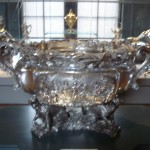
-
Giant Silver Punch Bowl at the V&A
-
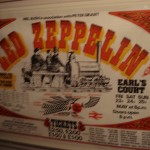
-
The Theatre and Stage Exhibit at the V&A
-
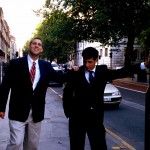
-
Brandon and I before Arcadia
-
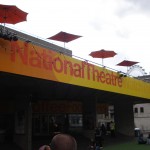
-
Outside the National Theatre
This Monday I experienced my first bank holiday. Because of our full schedule here this month it didn’t seem any different from any other day here. This held true until I wandered down Tottenham Court Road and realized that just about everything was closed. With just a handful of museums open I decided to use the time to visit one I hadn’t been to yet: The Victoria and Albert Museum.
I had been told great things about the V&A museum by classmates who had been there within the past few days so I went in with pretty high expectations. After seeing the first exhibit based on Great Britain from the 1600’s-1800’s I was not impressed. Boy would this opinion change. I walked up to the first floor and entered a giant gallery filled with all kinds of sculptures. This was easily the best sculpture gallery I had seen so far in London and I spent about 15 minutes walking through it and admiring. As I continued to walk through the entirety of the first floor I was absolutely astounded by the variety of exhibits this museum had to offer. Some highlights included a detailed exhibit on fashion, a room filled with giant monuments including a cross and decorative pillars and an exhibit on the Middle East and its textiles.
After a good hour spent on the first floor I ventured up to the third floor of the museum. As soon as I stepped into the silver exhibit I was in awe. I spent at least a half an hour admiring and studying silver used and manufactured in different time periods and parts of the world. My favourite was a giant punch bowl made entirely of silver. There were many other exciting exhibits on the third floor including one on theatre and a print exhibit featuring one of my late grandmother’s favorite authors, Beatrix Potter. My last stop on the third floor was the jewelry exhibit. In addition to being aesthetically pleasing the exhibit featured a timeline of jewelry that was considered fashionable since the start 18th century and a few small personal collections.
I could have spent at least another three hours in the Victoria and Albert museum but I decided to hold off for another day. The thing that impressed me the most about this museum was the variety of exhibits. Just about every other museum I had visited so far in London I knew what to expect going in. The V&A featured anything and everything and had no qualms about doing so. I found this both refreshing and exciting.
The rest of my bank holiday was filled with a trip to the theatre. Upon request the entire class got “dolled up” for a performance at the Duke of York’s Theatre near Leicester Square. We saw Arcadia, a Tom Stoppard play that turned out to be both extremely funny and thoughtful. The class seemed a bit skeptical of how the play would be at first glance since we couldn’t see much of the stage but as soon as the curtain went up things improved immediately. Neil Pearson’s performance as Bernard Nightingale was unmatched and fit perfectly with Samantha Bond’s character of Hannah Jarvis. The play was not only entertaining and made me think but also fit in perfectly with our program since it contrasted the humanities and sciences.
Ever since seeing Troilus and Cressida last Friday I have been craving anything to do with the theatre. This happened to be perfect timing as we spent all of Tuesday focusing on the stage. In the morning we had a fantastic conversation with Rick Fisher , a Dickinson alum of 1979 and a recipient of two Tony Awards, most recently for his work on Billy Elliot: The Musical. It was fascinating speaking with a Dickinson graduate who had simply worked his way up from the very bottom of the London theatre scene.
In the afternoon the class toured the National Theatre. Our tour guide took us through all parts of the building including the three main theaters. The Olivier, which is the largest, seats about 1100 people and does not have a bad seat in the house. My favorite part about the Olivier was that the main stage could be divided in half and raised and lowered at any time. In addition to the Olivier we also viewed the Cottesloe Theatre a black box that has the capability of being transformed into just about anything. All of the chairs in front of the stage can fold down and the risers they sit on can be pushed in creating additional stage space. The tour guide described a play that had been recently performed in the Cottesloe where the actors were mixed in with the audience. This amazed me. We also viewed the Lytellton Theatre where our class will be viewing the Pitmen Painters together next week. The other part of the tour that really amazed me was the props department. From the crocodile in Peter Pan to a severed head no prop was impossible to create.
After the tour of the National Theatre many of us were so excited about coming back that we decided to go see Shakespeare’s All’s Well That End’s Well, the play taking place in the Olivier currently. My reaction to the play was mixed. The theatre itself was amazing. The props, sets and lighting blew my mind and the acting was good overall. Despite all of these positives I didn’t particularly enjoy the actual play, especially the ending. It seemed impractical to me and unlikely to happen in real life, even 500 years ago.
Overall learning about theatre in London has been a lot of fun. In addition to seeing a variety of shows we’ve gotten a chance to see London theatre from many different perspectives. From the traditional globe experience to hearing about small fringe productions from Rick Fisher to a tour of all three main facilities at the National Theatre we have received a wide perspective of how this popular activity has influenced the city as a whole and in all different ways, shapes and forms.
Tags: Henry · Museums · Theatre
London is a city where the past is constantly present. What do I mean by that? Different countries maintain a dialogue with their history in a different way. Some countries are older than others. For example, in Argentina, where I come from, there are some plaques and monuments, but not so many as in England. One of the obvious reasons is because Argentina is a much younger country of only 200 years, and therefore has less history. But I do not think this is the main reason. In London, I get a feeling that time is cyclical, and that history comes back to us in many forms and shapes. We see it present on the street, in houses, in museums, in pubs and in its people.
During our trip, Prof. Qualls has been using the word juxtaposition. Indeed, in London we have found that not only architecture presents juxtaposed old and new buildings, but also different situations, like the helicopters during our play at the Globe theatre. I want to use a more complicated word which I am not sure if I made up since I am translating it from Spanish: trans-textuality. By this I mean the dialogue between two texts or two authors. While this is common in literature since most texts have their foundations on previous texts, it is a technique that is most common in Shakespeare and that I’ve been founding in London in general. This idea that if we build a new building, we will find the remains of others. Like we saw on our Roman walking tour. If a family moves to a new house, they will probably discover who lived there, like we saw in our Bloomsbury walking tour, and the many plaques saying the personalities who lived in the different houses. If I go see a play, trans-textuality is always there. It can be Troilus and Cressida, a story built inside another story (the Trojan war), or Arcadia, by Tom Stoppard, which also dialogues with the past and real life English characters such as Lord Byron.
Being in a city as old as London makes me constantly question about the past, from who has lived in what we now know as the Arran House Hotel, to what will my mark be, as the story of London progresses.
Tags: Azul
The Notting Hill Carnival was amazing; done. The smells were what did me. The blend of jerk chicken, sweat, and cannabis were overwhelmingly wonderful; a symphony for the nostrils. Each note sliding through your mind yet blending harmoniously. Needless to say, coming at 930 was not necessary at all, but it quickly picked up in volume and entertainment. The scantilyclad women didn’t grab my time or attention as much as it seems others did, and I didn’t really even check out of the parade that much. What I did love was the competing food stands and street dancing. Each stand seemed to be family owned and operated, which is something I’m seeing more and more of in England. It is also something that I didn’t see a lot of in America. Back to the Carnival. I am still on the fence about one thing though: the overbearing shroud of alcohol. Many of the parade groups had very overt sponsorship from alcohol companies, and it seemed like they were trying desperately to get people drunk.
Then there was the play. Everyone looked so wonderful, and it was so great to get dressed up. Then we got to the Theatre. The seats were tiny and there were tons of people wearing jeans. I will be the first to admit that plays often mean nap time for Andrew. But I’ve really liked the two shows we’ve seen and stayed awake for both of them (the globe was a tricky one to fall asleep in). Arcadia was really cool. The story was ok, but I really liked the execution. The lighting changes and the minimalist scenery also tied things together well. I really liked the scene where the two time periods overlap at the end, neat effect to do on stage. The concept of historians getting something completely wrong because they are looking to become famous is a message that is often times downplayed. We are lost in the pursuit of knowledge, allowing ambition and hope to guide us where discretion should. But then again, that’s the trick about history: unless there are direct records, it’s all just speculation. And no matter how much research you attain, you can never get rid of you bias. Anthropology and Archeology are more slaves to this than other humanities. We look at a few sherds of pottery, and we “know” quite a bit about the culture but too often we forget the interpersonal stories.
The stark contrast between the theatre we saw Arcadia in and the Globe theatre is aparent the moment you step into each. The Globe is as some many have already said was quite “Disney” but you know what? I liked it. The open air and the huddling together– it worked really well, and it helped to blend the worlds of reality and play together. On the other hand, Arcadia’s theatre kept you firmly planted in your world. The boxed theatre and cramped seating as well as the drastic lightings were firm reminders of the wall between the actors and viewers.
Tags: Andrew R
September 1st, 2009 · 1 Comment
It has been awhile since I have actually stepped back and appreciated how much work and effort goes into a theatrical production. My last personal experience with a theatrical production was playing in the pit orchestra in a high school production of “How to Succeed in Business without Really Trying” during my sophomore year. The last time I had performed in a play or helped with costumes and set was in fifth grade. Needless to say, I had allowed myself to forget the hard work and dedication required to put on a successful theatrical production. Obviously I have attended numerous plays, musicals and operas since then, but I only viewed it as an audience member paying attention to the final product. I had forgotten to appreciate the intricacies of sets, costumes, rehearsals, props, and production staff. This held true even up until last night when we saw Arcadia. I loved the play and found the script to be beautifully written in order to convey a powerful message concerning time and how it passes. Yet the details of the lighting, set, props and backstage work escaped me.
It was not until this morning’s discussion with Rick Fisher that I began to understand the intricacies of lighting, sets, and other backstage work. I wish we could have talked with him before seeing Arcadia. Looking back, I can understand the importance of lighting beyond the obvious cues it provides. Truly, it made me more appreciative of the lighting design we experienced with Arcadia. It was simple but artistic in that it successfully conveyed not only the time of day but the difference in the time periods. At that time I had decided to appreciate the lighting and other backstage works of the plays we would be seeing in the rest of our time in London. I thought that would be the end of it. Yet, I found that our backstage tour at the National Theatre really drove home that point. Not only did it further my newfound appreciation for the collaborative effort required to produce a theatrical even, but it also revitalized my excitement for the theater. A few years had passed since I had been truly excited to see, experience and appreciate a theatrical production. But, with this new appreciation and insight about the production of a play I find myself with a new found passion for the theater. This is something I did not expect from our time in London. I thought I would find myself discovering passions for the city, its architecture, parks, museums, et cetera; not for theater. It is a wonderful discovery and one that will be far too easy to indulge in while we are here and in Norwich. Hopefully, I can take this with me when we return in June but for now I am more than content to take this new knowledge and explore the theaters and plays of London and Norwich.
Tags: Kimberly · Uncategorized
Possibly one of the most personally thrilling aspects of being in London are our ventures out to its numerous theatres. I have always enjoyed the performing arts – backstage, onstage, and in the audience. Besides finding performing onstage a thrill, I enjoy theatre for its ability to transport, reflect, commentate, and juxtapose. It takes a subject (society, culture, science, etc) and turns it into a picturesque/edgy/nonsensical/expressive form for an awaiting audience. Some interact with the audience face-to-face, while others prefer to let the audience engage with the performers from their seats. Either method has its immediate advantages and disadvantages, but both demand some reflection.
London has provided several different uses for theatre. I guess it sounds odd to see theatre as a “tool”, but it undoubtedly has some uses. Take, for instance, the plays of Noel Coward (the subject of my research paper). His plays (usually comedies) make some social commentary of British society during the 1920s, 30s, and 40s – the time during which he wrote his plays. Theatre can be used as ways to mock, mimic, reflect, or reinforce themes found recurring in society. Even today, we learned about the play An Inspector Calls from Rick Fisher, the show’s lighting designer. As a commentary on wealth and the prevalence of blissful ignorance, this play aims, in part, to lead the audience towards some sort of understanding of self-reflection and self-improvement. Certainly a single show does not always solve these issues, but J.B. Priestley – the author – certainly saw the point of confronting them.
On the other hand, theatre can, and does, entertain. Take the list of musicals available in the West End. Several are highly entertaining and well-done. No, they do not always include profound thought or interesting social commentary, but the story is usually popular and well received. Some are edgy, but many have glitz and glamour and are eagar to please audiences (e.g. Legally Blonde the Musical). I can’t really argue that this theatre is useless and without meaning – primarily due to the fact that I have seen some of the shows on that list (I am still holding out on Sister Act the Musical, though. Don’t worry.).
But London theatre also combines the two in order to deliver entertaining yet serious shows. The two shows we have seen – Shakespeare’s Troilus and Cressida and Stoppard’s Arcadia – exemplify their successful combination. Both reflect on the ways of the past and comment, albeit loosely, on British society. Both entertain their audiences by pricking their minds and engaging their attention through clever language or comedic timing. Both frustrate and confuse their audiences due to fast-paced or even outdated language. Both step into the far reaches of complex issues ranging from love and thermodynamics. Both were enjoyable in this way, or, at the very least, deserving of some appreciation as works of performance art.
Theatre has several universal properties (namely the several noted above – social commentary, entertainment, etc.). London has adapted these properties to fit its own diverse audiences by providing a long list of plays, musicals, and other forms of performance art in the theatre. Each has its own purpose. Each attracts a different type of London theatre-goer. I often walk outside the auditorium during intermission simply to look around and listen to the other people around me. These people may or may not be seeing the same show that I am watching. It’s at this point in my experience of London theatre that I wonder who you can really pin down as a London theatre-goer. Can you even identify them?
I hope my next outing to see All’s Well that Ends Well will help bring me closer to providing an answer.
**The title of the post is a quote from Tom Stoppard’s Arcadia.
Tags: Brandon
I’m going to be perfectly honest: I’ve never been a big fan of the theater. I’m the sort of person who will go see anything and be able to appreciate it or be critical of it for seemingly valid reasons, but I’ve just never really enjoyed live theater the way I do films: the choice of only one or two settings has always felt extremely limited for my wild and vivid imagination, I’m a bit hard of hearing and can’t turn the volume up on live actors, people don’t suddenly break into coordinated song and dance routines in real life, there’s a huge margin of error for mistakes and unwelcome variation between performances, and it’s much harder to blow things up and create huge messes on a stage. I’m a fan of realism and authenticity, and sometimes I just can’t suspend my disbelief with plays the way I can with movies.
All of this being said, I’ve always been fascinated by the production aspect of live theater. I was heavily involved with the production and tech crews at my high school, and I used to enjoy nothing more than Hell Week before opening night, sitting in the black box theater in the wee hours of the morning, flicking lights on and off, organizing props, and putting finishing touches on the set. After hearing Rick Fisher speak about his experience with the theater and taking the tour of the National Theatre today, I’ve started longing to go back to stage managing and tech production. I’m attempting to see as many plays as I can during our time in London in order to try to condition myself into enjoying being an audience member, but I think I will always prefer being a part of the action rather than watching it. I kind of wonder if this is a problem: enjoying working very hard towards an end product you don’t really care for.
I’ve never been an avid play-goer before this trip, but I feel as though the West End has a bit less glitz and a bit more pride than Broadway. Perhaps pride is the wrong word, and perhaps I’ve been seeing and hearing of the wrong plays, but I often think of many Broadway plays as being a good and expensive night out, but the West End seems to treat the plays as more of an art form and something that everyone should be able to enjoy and appreciate. If the advertisements on the Tube are any judge, the West End has its fair share of mindless plays based on popular movies, but the simple fact that there are cheap seats, student discounts, overwhelming amounts of Shakespeare, government funding, and seemingly many more British film and television stars on the stage as well as the screen (working for meager amounts of money) makes me believe that in England, the theater is more of a cultural institution meant for everyone rather than deep appreciation for few, or simple entertainment.
I grew excited last night upon learning that Arcadia was written by Tom Stoppard, who also wrote Rosencrantz and Guildenstern are Dead and co-wrote Shakespeare in Love. I seemed to have forgotten, however, that his work, while usually hysterical and thought-provoking, is also very dense and requires a fine-toothed comb to find all of the hidden jokes, references, and subject matters. This, coupled with the fact that I was inexplicably exhausted and that my hearing can be likened to that of a seventy-year-old man’s made me unable to completely follow much of the play, but apparently I wasn’t alone. I think reading it would make things clearer.
I’m foregoing the next performance at the Globe simply because I don’t know if my back could handle another few hours as a groundling, but I’m attending All’s Well That Ends Well tomorrow night in its stead in a valiant effort to see more plays, learn to appreciate the finished product rather than just the behind-the-scenes work, and learn to like Shakespeare.
Tags: Chelsea · Theatre










